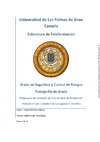Identificador persistente para citar o vincular este elemento:
https://accedacris.ulpgc.es/jspui/handle/10553/68087
| Campo DC | Valor | idioma |
|---|---|---|
| dc.contributor.advisor | Luján Henríquez, Isabel María | - |
| dc.contributor.author | Modino Núñez, Paulino Alejo | - |
| dc.date.accessioned | 2020-01-23T03:17:59Z | - |
| dc.date.available | 2017-07-31T00:00:00Z | es |
| dc.date.available | 2020-01-23T03:17:59Z | - |
| dc.date.issued | 2016 | en_US |
| dc.identifier.other | contentdm-postulpgc | es |
| dc.identifier.uri | https://accedacris.ulpgc.es/handle/10553/68087 | - |
| dc.description.abstract | El principal objetivo de este estudio es analizar la viabilidad de implantación de una Unidad de Mediación Policial en el Área de Seguridad Ciudadana y Movilidad del Ayuntamiento de San Cristóbal de La Laguna. Se ha utilizado la metodología cualitativa y para ello se ha realizado un cuestionario ad hoc de 14 preguntas relacionadas con los objetivos de la investigación y se ha aplicado a 21 sujetos considerados informantes clave por el alto conocimiento que poseen de la realidad que se va a investigar. Dichos sujetos pertenecen a la Policía Local y Servicios Sociales del citado ayuntamiento y personal de la Administración de Justicia. Los resultados nos indican que los tipos de conflictos que más abundan son los vecinales y familiares, existiendo unanimidad en cuanto a que la Policía debe conocer y emplear técnicas de resolución de conflictos. Todos los participantes coinciden en que es necesaria la creación de una Unidad de Mediación para llevar a cabo una mediación formal con protocolos estructurados. Algunos profesionales, además, especifican que se debería crear conjuntamente con personal especializado de otras áreas del Ayuntamiento. También se resalta la necesidad de formación en resolución de conflictos en la Policía, tanto para la futura unidad como para el resto de la plantilla. Asimismo, los resultados muestran que la resolución de conflictos por parte de los Agentes de Policía puede basarse en la mediación sin descartar otros métodos, ya que lo fundamental es avanzar con la ciudadanía en un cambio positivo en la visión del conflicto. | en_US |
| dc.description.abstract | The main object in this study is to analyze the viability that exits in the introduction of a Mediation Unit in the area of Public Safety and Mobility from the local government (Town Hall) of San Cristóbal de La Laguna. It has been used the qualitative methodology, performing an investigation “ad hoc” with 14 questions related with the aims of the investigation to 21 individuals considered key informants because of the high level of knowledge possessed of the reality to investigate. These individuals belong to the Local Police forces and the Social Services in the so mentioned local government and staff from the Justice Administration. The results show us that the kinds of disputes which are the most commonly seen, are the neighborhood and family ones, existing an unanimity in the use of techniques, which the police must practice in dispute resolutions. Every interviewer agrees in the creation of a Mediation Unit that is required to carry out a formal mediation unit with structured protocols. Some professionals, in addition, specify that it should be created jointly with personnel from other areas of the local government. It also stands out the need for training in dispute resolution in the police, both for the future unit and for the rest of the staff. In this way, the results show that the dispute resolution by police officers can be based on mediation, without ruling out other methods, since the fundamental thing is to move forward with citizenship in a positive change in the vision of the dispute. Key words: mediation, police, conflicts, formation. | en_US |
| dc.format | es | |
| dc.language | spa | en_US |
| dc.rights | Acceso restringido para la comunidad universitaria de la ULPGC | es |
| dc.subject | 610901 Prevención de accidentes | en_US |
| dc.title | Propuesta de creación de una Unidad de Mediación Policial en San Cristóbal de La Laguna | en_US |
| dc.type | info:eu-repo/semantics/bachelorThesis | en_US |
| dc.type | BachelorThesis | en_US |
| dc.contributor.facultad | Estructura de Teleformación ULPGC | en_US |
| dc.identifier.absysnet | 734858 | es |
| dc.type2 | Trabajo final de grado | en_US |
| dc.description.notas | Grado en Seguridad y Control de Riesgos | en_US |
| dc.utils.revision | Sí | en_US |
| dc.identifier.matricula | TFT-38115 | es |
| dc.identifier.ulpgc | Sí | en_US |
| dc.contributor.buulpgc | BU-TEL | en_US |
| dc.contributor.titulacion | Grado en Seguridad y Control de Riesgos (No Presencial) | es |
| item.grantfulltext | restricted | - |
| item.fulltext | Con texto completo | - |
| Colección: | Trabajo final de grado Restringido ULPGC | |
Visitas
114
actualizado el 20-ene-2024
Descargas
34
actualizado el 20-ene-2024
Google ScholarTM
Verifica
Comparte
Exporta metadatos
Los elementos en ULPGC accedaCRIS están protegidos por derechos de autor con todos los derechos reservados, a menos que se indique lo contrario.
